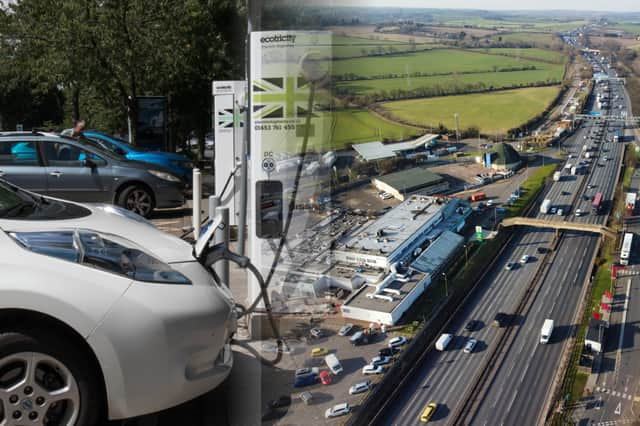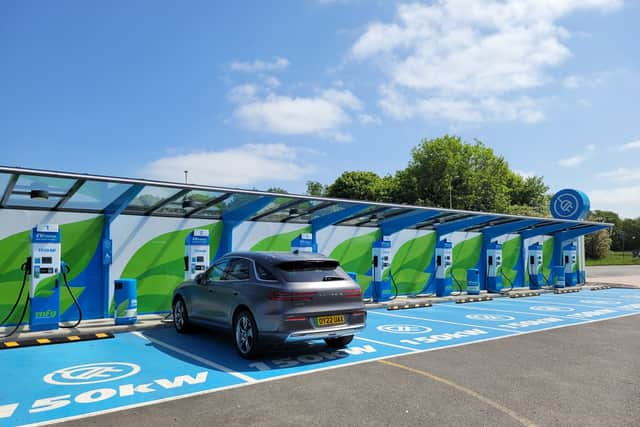Rabid refuseniks and smug EVangelists do little to help EV charging debate


Recently, actor Rowan Atkinson was hailed by some and lambasted by others for saying he felt "duped" by electric cars, shortly before the BBC’s Panorama caused conflict over how it portrayed the UK’s charging situation.
The show was criticised by some over its reporting of the availability and ease of use of chargers as well as for cherry picking comments from obvious opponents of EVs, while others argued it painted a realistic picture of a struggling system and unsuitable vehicles.
Advertisement
Hide AdAdvertisement
Hide AdListen to one side and the UK is on course to grind to a halt as we're all stranded at the roadside with flat batteries. Listen to the other and we're already living in a green utopia where journeys take no longer than in a petrol car and there are plenty of chargers for everyone.
My own experience suggests the truth is somewhere in the middle, although that’s sometimes hard to tell amid the know-it-all smugness and pig-headed ignorance from either side of the discussion.
I’ve driven EVs the length of Scotland at virtually no cost and with no problems, then struggled to find a working device within 10 miles of my house. I’ve covered 400 miles in one car with just a single charging stop but also had to charge another twice to complete a 120-mile trip.
Recently, I took a 700-mile trip from Scotland to Bedfordshire and back to see how the long-distance motorway infrastructure stacks up and was pleasantly surprised. With a little bit of forward planning, my Genesis GV70 Electrified test car managed the two-day trip with just three quick and easy charging stops.
Advertisement
Hide AdAdvertisement
Hide AdWhile Panorama’s presenter apparently experienced endless problems finding then connecting to suitable chargers, I rolled into each clean and well-lit location, had my pick of up to 12 ultra-rapid chargers, tapped my payment card and was back on the road in less than half-an-hour with more than 80% charge. A colleague travelling to the same destination from Yorkshire was not so lucky, fighting to find suitable locations and anything more than a 50kW charge on his trip up the east coast.
My trip was easy thanks to plentiful provision of new and well maintained chargers along the M6 and M1, but availability and reliability of public devices remains one of the key concerns around EV ownership. Research by NationalWorld’s data team found that while some council areas have almost one public charger per plug-in vehicle, in other areas more than 100 EVs and PHEVs are potentially fighting over a single device. And separate research found that in some areas a fifth of devices are faulty at any one time.


While up to 80% of charging is done at home, longer journeys require the use of public charging but a recent study by the RAC also found that even on major motorways provision is patchy. In England, just a quarter of service stations currently have six or more rapid chargers - the target set by the government for the end of 2023. Six of the 119 locations have none at all.
There are growing numbers of large charging sites just off major motorways. I used two MFG EV Power stations within five minutes of the M6, each with at least eight devices and both next to 24-hour filling stations. And firms like Gridserve and Osprey are rapidly opening dedicated EV service stations with dozens of ultra-rapid chargers, shops and cafes close to major transport hubs.
Advertisement
Hide AdAdvertisement
Hide AdCharger roll-out is accelerating all the time, too. According to Zap-Map an average of 1,625 new chargers were installed each month in the first quarter 2023, compared with 914 per month in the same period in 2022. And the number of ultra-rapid chargers - which can add more than 100 miles in less than 20 minutes, slashing waiting times - is increasing at an even faster pace.
However, with around 43,000 public chargers in total and EV uptake accelerating even faster, infrastructure expansion will need to accelerate even more to reach the government’s stated target of 300,000 devices by 2030.
Among the other concerns raised by the Panorama documentary was the proliferation of different networks, many with their own sign-up and payment requirements. Most new devices now accept payment via debit or credit card but this is still not the case everywhere, leaving drivers to fill in online registrations before they can charge.
In such cases, “roaming” cards like the Cinchcharge card I was testing offer a simplified and centralised payment method. Cinchcharge (provided to customers of the online dealer), like Zap-Pay, Octopus Electroverse and Bonnet allows you to use one card or app, linked to a credit or debit card, to pay for charging on multiple networks without a subscription.
Advertisement
Hide AdAdvertisement
Hide AdIt’s a useful solution for when you encounter a charger that doesn’t accept credit/debit cards and one that the BBC show failed to mention. But it comes with its own issues, mainly that no one card covers every single network, so you’re still left searching for devices compatible with your “all-in-one” card.
If anything, the issues highlighted by the Panorama episode were as much to do with driver education as they were about the infrastructure. Many of the anti-EV comments from members of the public were based on misconceptions or outdated concepts, highlighting a lack of understanding.
At the same time, the presenter Richard Bilton was criticised by a vocal section of EV fans for “playing dumb” and not understanding the differences between chargers, while failing to check the speed and reliability of a station before trying to use it.
Such things may be obvious to committed EV fans, who enjoy geeking out over charger speeds, route planning and charger availability but for most people a car is a tool to do a basic job.
Advertisement
Hide AdAdvertisement
Hide AdI wouldn’t spend hours researching how to use a new fridge, washing machine or TV, and most people feel the same about their cars. So the presenter’s problems are likely to reflect those encountered by people for whom an EV is simply another white good that should do its job with the minimum of effort from them.
Owners’ lack of interest is exacerbated by a lack of advice or help from those selling the cars. On my recent trip I encountered one driver who had been delivered a new Audi e-tron company car. The only advice he was given at handover was where the charging port was, with no guidance on how to find or use chargers.
A senior figure from one of the UK’s biggest chargeplace operators told me about seeing a driver trying to plug their home Type 2 cable into the end of a CCS cable at a public charger, because no-one had explained the difference between home AC and public DC devices. He also spoke to a couple who were oblivious to the fact they had bought one of the fastest-charging cars in the country, despite having spent almost £50,000 on it.
Drivers clearly have some responsibility to understand their often expensive vehicles, but there must also be an onus on manufacturers and dealers to make sure they are helping their customers get the most from their vehicles or risk putting them off and fuelling misconceptions.
Advertisement
Hide AdAdvertisement
Hide AdThere also needs to be an understanding among the more enthusiastic that not everyone is as clued-up as them. In my experience, most of the EV community is friendly and helpful but the BBC documentary brought out a wealth of self-satisfied online commentators keen to show off how clever they were without offering any helpful advice to the less knowledgeable. At the same time there were plenty of uninformed “petrolheads” happy to use the show’s flawed arguments as proof that EVs are a dead end.
Neither position is particularly helpful for those considering an EV or starting on their EV journey, for whom a realistic picture of what to expect - good or bad - is far more important.
Comment Guidelines
National World encourages reader discussion on our stories. User feedback, insights and back-and-forth exchanges add a rich layer of context to reporting. Please review our Community Guidelines before commenting.
